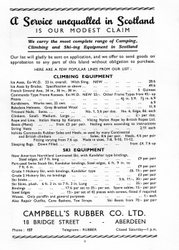
The Scottish Mountain Heritage Collection
Objects Database
Brades Ice Axe (modified)
Accession Number
1394.2017.1
Object Name
Brades Ice Axe (modified)
Created
11/05/2017
Creator
Hermione Cooper
Accession Date
11/05/2017
Brief Description
Brades Ice Axe (modified) with wooden shaft and serrated pick. Attached rope wrist loop.
Materials
wood, metal, rope
Dimensions
Shaft 61(L) head 29(L) cms
Number Of Objects
1
Inscription Description
On pick "BRADES 1943" and ↑
Colour
brown, silver
Maker
Brades
Provenance
Brades seems to have begun life way back in 1782 when a man called William Hunt bought the Brades Estate near Oldbury, Birmingham and started a steelworks there. The company became William Hunt & Son in 1809 though the Brades trade mark remained, quickly gaining a prestigious reputation in the 'edged tool' market, which in the early days included items such as axeheads, hatchets, trowels, spades, garden shears, wood chisels and scythes.
With that kind of expertise it's little wonder that the Ministry of Defence approached them in the 1940's to make ice axes for the various mountain troops who were operating in World War Two. Though we are not 100% sure it's pretty certain that's what happened. It's also interesting to note that the Scottish Regiment known as the Lovat Scouts went to train amid the icefields of the Canadian Rockies in 1943 and were issued with Brades ice axes.
Mountaineers in the 1940's and 50's relied heavily on ex-army gear and the government surplus shops were selling off Brades Axes, amongst other things, as you can see from the advert opposite.
Having acquired one of these axes, climbers often shortened them to make them more manageable when climbing steep ice so a pal of Eric Derwin's (who donated this axe) has done a very good job of shortening this one. Another interesting variation on a Brade's original.
Acquisition Method
Donated by Eric Derwin
Acquisition Date
11/05/2017
Condition Check Date
11/05/2017
Rules
Spectrum : UK Museum documentation standard, V.3.1 2007
Modified
11/05/2017

